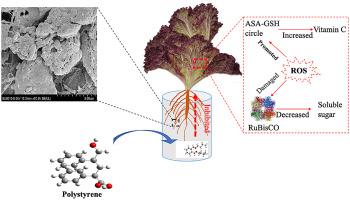Environmental Pollution ( IF 8.9 ) Pub Date : 2021-03-04 , DOI: 10.1016/j.envpol.2021.116871 Youming Dong , Zhengguo Song , Yu Liu , Minling Gao

|
Microplastics, an emerging pollutant in the environment, have attracted extensive attention in recent years for their possible negative impact on organisms. However, direct and indirect effects of polystyrene (PS) microplastics on vegetables are still not completely known. In this study, we used red lettuce (Lactuca sativa L. Red Sails) in a hydroponic system to investigate the effects of nano- and micro-sized PS and dibutyl phthalate (DBP) on the photosynthesis and red lettuce quality. The results clearly indicated that PS reduced the bioavailability of DBP while causing a decrease in the photosynthetic parameters as well as the total chorophyll content compared to DBP alone by affecting the crystalline structure of the water-soluble chlorophyll protein. Compared with DBP monotherapy, the presence of PS significantly increased hydrogen peroxide and malondialdehyde content in the lettuce treated with DBP, indicating serious oxidative damage. Furthermore, the soluble protein and sugar content in lettuce leaves decreased with higher PS concentration and smaller PS size. It may be due to PS inhibited lettuce root and ribulose-1,5-bisphosphate carboxylase/oxygenase activities. In contrast, nitrite content increased significantly with the induction of the glutathione-ascorbic acid cycle, indicating that the presence of PS reduced the quality of DBP-treated-red lettuce. Additionally, the nano-sized PS greatly inhibited lettuce growth and quality more than the micro-sized PS. This study described the interactions between microplastics and phthalates using molecular simulation and experimental validation to highlight the potential risks of microplastics on vegetable crop production.
中文翻译:

聚苯乙烯颗粒与邻苯二甲酸二丁酯的组合会导致光合作用和生菜质量显着下降
微塑料是环境中的一种新兴污染物,近年来因其可能对生物体产生负面影响而引起了广泛关注。但是,聚苯乙烯(PS)微塑料对蔬菜的直接和间接作用仍不完全清楚。在这项研究中,我们使用了红色的生菜(莴苣L. Red Sails)在水培系统中研究纳米和微米级PS和邻苯二甲酸二丁酯(DBP)对光合作用和红色生菜质量的影响。结果清楚地表明,与单独使用DBP相比,PS通过影响水溶性叶绿素蛋白的晶体结构,降低了DBP的生物利用度,同时导致光合参数以及总叶绿素含量降低。与DBP单一疗法相比,PS的存在显着增加了DBP处理过的莴苣中的过氧化氢和丙二醛含量,表明存在严重的氧化损伤。此外,莴苣叶片中的可溶性蛋白质和糖含量随着PS浓度的升高和PS尺寸的减小而降低。这可能是由于PS抑制了莴苣的根和核糖1的缘故,5-双磷酸羧化酶/加氧酶活性。相反,随着谷胱甘肽-抗坏血酸循环的诱导,亚硝酸盐含量显着增加,表明PS的存在降低了DBP处理的红色生菜的质量。此外,纳米级PS比微米级PS更大程度地抑制了生菜的生长和品质。这项研究使用分子模拟和实验验证描述了微塑料与邻苯二甲酸酯之间的相互作用,以突出微塑料对蔬菜作物生产的潜在风险。纳米PS比微米PS对生菜的生长和品质的抑制作用更大。这项研究使用分子模拟和实验验证描述了微塑料与邻苯二甲酸酯之间的相互作用,以突出微塑料对蔬菜作物生产的潜在风险。纳米PS比微米PS对生菜的生长和品质的抑制作用更大。这项研究使用分子模拟和实验验证描述了微塑料与邻苯二甲酸酯之间的相互作用,以突出微塑料对蔬菜作物生产的潜在风险。



























 京公网安备 11010802027423号
京公网安备 11010802027423号